Auditing and Assurance: ASA 315, ASA 520 and Analytical Procedures
VerifiedAdded on 2021/05/31
|7
|1314
|53
Report
AI Summary
This report provides a comprehensive overview of auditing and assurance, specifically focusing on Australian Accounting Standards ASA 315 and ASA 520. ASA 315 addresses the auditor's responsibility in identifying and assessing the risk of material misstatement in a company's financial reports, considering the company's environment and internal controls. ASA 520 focuses on the auditor's use of analytical procedures as substantive procedures to form an overall conclusion on financial statements. The report details how analytical procedures are used in both risk assessment and substantive procedures, including ratio analysis, trend analysis, and reasonableness testing. It also explores specific examples like inspection of inventory and observation of fixed assets. The report emphasizes the importance of selecting appropriate analytical procedures based on the desired level of assurance and professional judgment. References to relevant literature support the analysis.
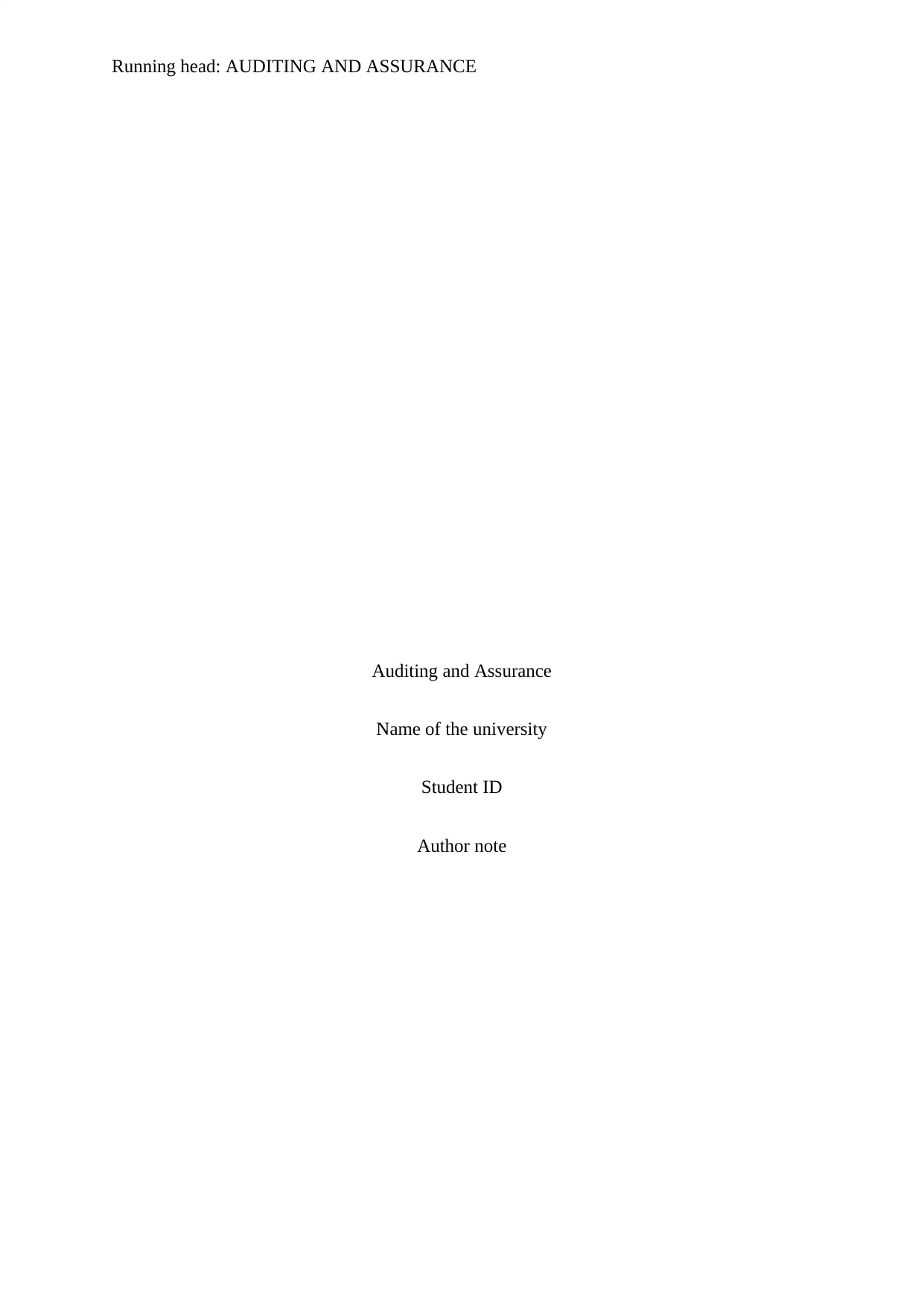
Running head: AUDITING AND ASSURANCE
Auditing and Assurance
Name of the university
Student ID
Author note
Auditing and Assurance
Name of the university
Student ID
Author note
Paraphrase This Document
Need a fresh take? Get an instant paraphrase of this document with our AI Paraphraser
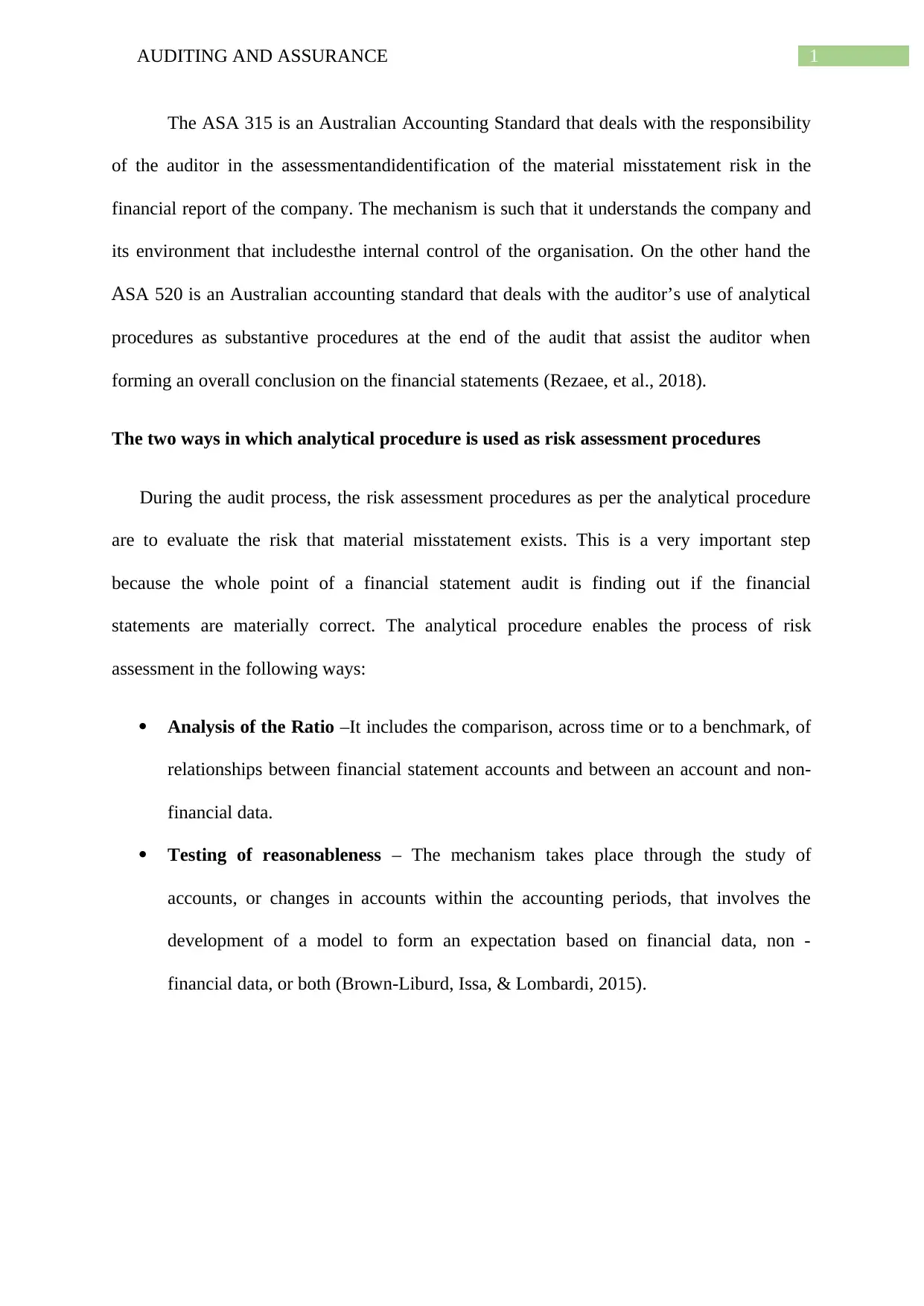
1AUDITING AND ASSURANCE
The ASA 315 is an Australian Accounting Standard that deals with the responsibility
of the auditor in the assessmentandidentification of the material misstatement risk in the
financial report of the company. The mechanism is such that it understands the company and
its environment that includesthe internal control of the organisation. On the other hand the
ASA 520 is an Australian accounting standard that deals with the auditor’s use of analytical
procedures as substantive procedures at the end of the audit that assist the auditor when
forming an overall conclusion on the financial statements (Rezaee, et al., 2018).
The two ways in which analytical procedure is used as risk assessment procedures
During the audit process, the risk assessment procedures as per the analytical procedure
are to evaluate the risk that material misstatement exists. This is a very important step
because the whole point of a financial statement audit is finding out if the financial
statements are materially correct. The analytical procedure enables the process of risk
assessment in the following ways:
Analysis of the Ratio –It includes the comparison, across time or to a benchmark, of
relationships between financial statement accounts and between an account and non-
financial data.
Testing of reasonableness – The mechanism takes place through the study of
accounts, or changes in accounts within the accounting periods, that involves the
development of a model to form an expectation based on financial data, non -
financial data, or both (Brown-Liburd, Issa, & Lombardi, 2015).
The ASA 315 is an Australian Accounting Standard that deals with the responsibility
of the auditor in the assessmentandidentification of the material misstatement risk in the
financial report of the company. The mechanism is such that it understands the company and
its environment that includesthe internal control of the organisation. On the other hand the
ASA 520 is an Australian accounting standard that deals with the auditor’s use of analytical
procedures as substantive procedures at the end of the audit that assist the auditor when
forming an overall conclusion on the financial statements (Rezaee, et al., 2018).
The two ways in which analytical procedure is used as risk assessment procedures
During the audit process, the risk assessment procedures as per the analytical procedure
are to evaluate the risk that material misstatement exists. This is a very important step
because the whole point of a financial statement audit is finding out if the financial
statements are materially correct. The analytical procedure enables the process of risk
assessment in the following ways:
Analysis of the Ratio –It includes the comparison, across time or to a benchmark, of
relationships between financial statement accounts and between an account and non-
financial data.
Testing of reasonableness – The mechanism takes place through the study of
accounts, or changes in accounts within the accounting periods, that involves the
development of a model to form an expectation based on financial data, non -
financial data, or both (Brown-Liburd, Issa, & Lombardi, 2015).
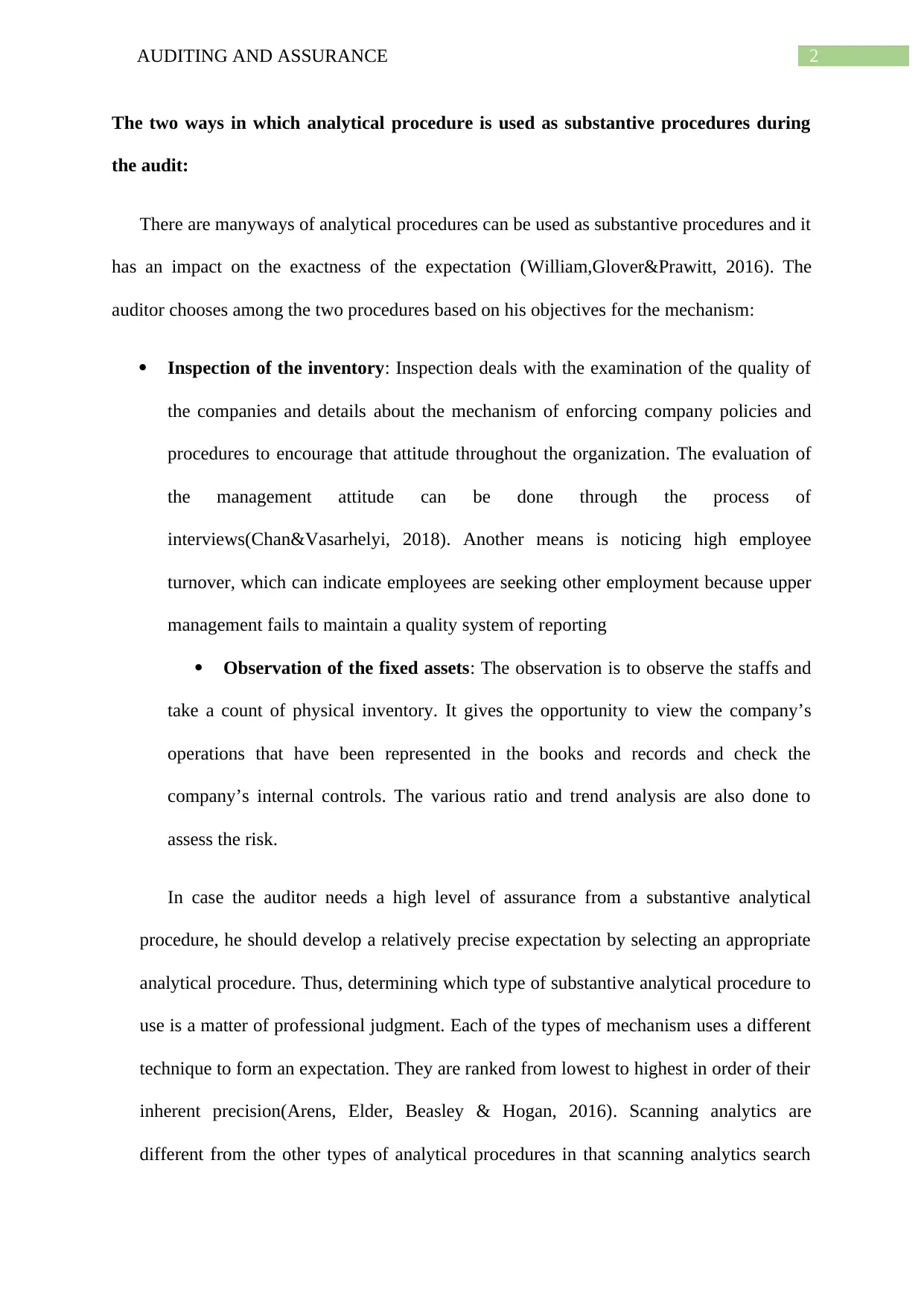
2AUDITING AND ASSURANCE
The two ways in which analytical procedure is used as substantive procedures during
the audit:
There are manyways of analytical procedures can be used as substantive procedures and it
has an impact on the exactness of the expectation (William,Glover&Prawitt, 2016). The
auditor chooses among the two procedures based on his objectives for the mechanism:
Inspection of the inventory: Inspection deals with the examination of the quality of
the companies and details about the mechanism of enforcing company policies and
procedures to encourage that attitude throughout the organization. The evaluation of
the management attitude can be done through the process of
interviews(Chan&Vasarhelyi, 2018). Another means is noticing high employee
turnover, which can indicate employees are seeking other employment because upper
management fails to maintain a quality system of reporting
Observation of the fixed assets: The observation is to observe the staffs and
take a count of physical inventory. It gives the opportunity to view the company’s
operations that have been represented in the books and records and check the
company’s internal controls. The various ratio and trend analysis are also done to
assess the risk.
In case the auditor needs a high level of assurance from a substantive analytical
procedure, he should develop a relatively precise expectation by selecting an appropriate
analytical procedure. Thus, determining which type of substantive analytical procedure to
use is a matter of professional judgment. Each of the types of mechanism uses a different
technique to form an expectation. They are ranked from lowest to highest in order of their
inherent precision(Arens, Elder, Beasley & Hogan, 2016). Scanning analytics are
different from the other types of analytical procedures in that scanning analytics search
The two ways in which analytical procedure is used as substantive procedures during
the audit:
There are manyways of analytical procedures can be used as substantive procedures and it
has an impact on the exactness of the expectation (William,Glover&Prawitt, 2016). The
auditor chooses among the two procedures based on his objectives for the mechanism:
Inspection of the inventory: Inspection deals with the examination of the quality of
the companies and details about the mechanism of enforcing company policies and
procedures to encourage that attitude throughout the organization. The evaluation of
the management attitude can be done through the process of
interviews(Chan&Vasarhelyi, 2018). Another means is noticing high employee
turnover, which can indicate employees are seeking other employment because upper
management fails to maintain a quality system of reporting
Observation of the fixed assets: The observation is to observe the staffs and
take a count of physical inventory. It gives the opportunity to view the company’s
operations that have been represented in the books and records and check the
company’s internal controls. The various ratio and trend analysis are also done to
assess the risk.
In case the auditor needs a high level of assurance from a substantive analytical
procedure, he should develop a relatively precise expectation by selecting an appropriate
analytical procedure. Thus, determining which type of substantive analytical procedure to
use is a matter of professional judgment. Each of the types of mechanism uses a different
technique to form an expectation. They are ranked from lowest to highest in order of their
inherent precision(Arens, Elder, Beasley & Hogan, 2016). Scanning analytics are
different from the other types of analytical procedures in that scanning analytics search
⊘ This is a preview!⊘
Do you want full access?
Subscribe today to unlock all pages.

Trusted by 1+ million students worldwide
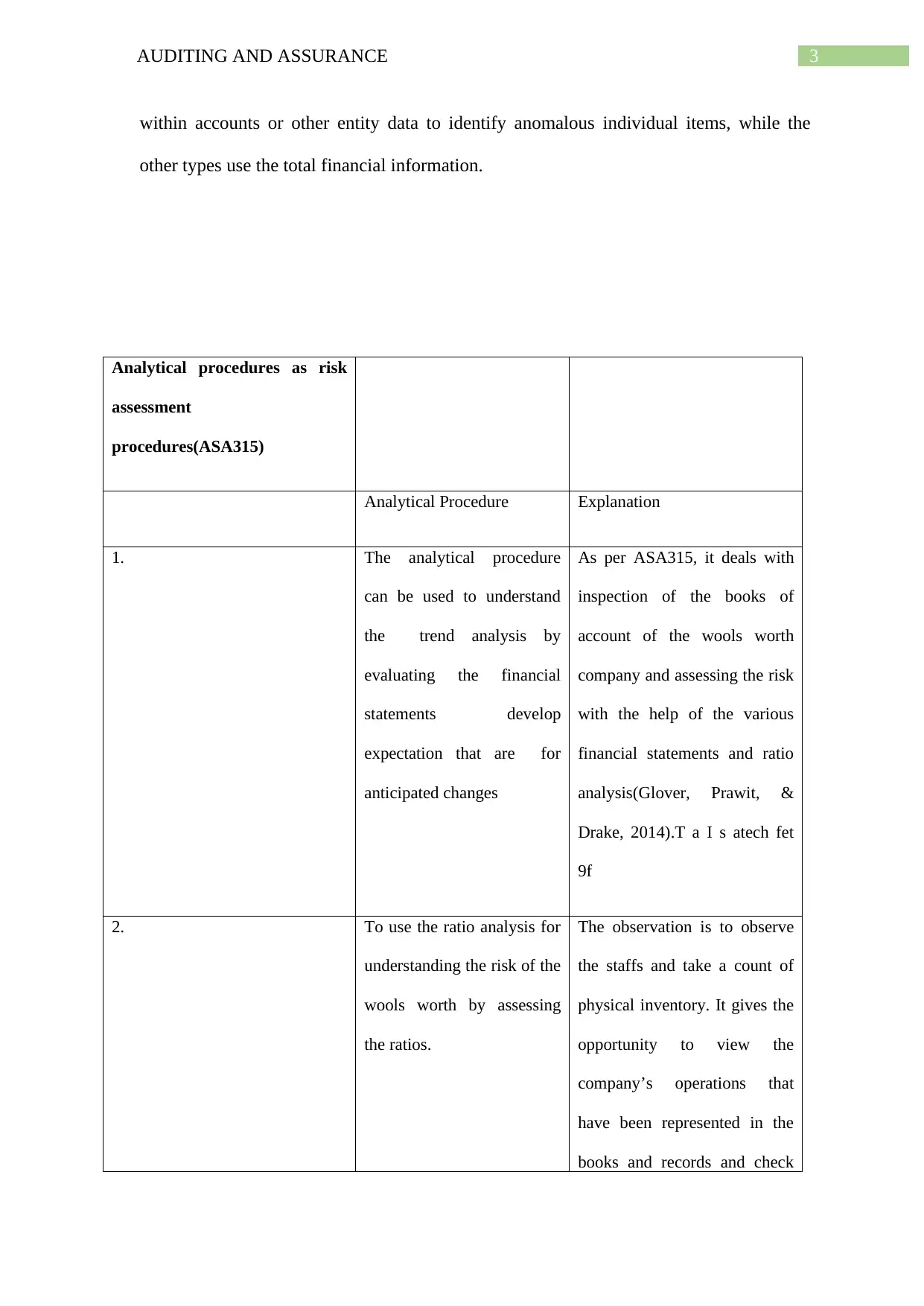
3AUDITING AND ASSURANCE
within accounts or other entity data to identify anomalous individual items, while the
other types use the total financial information.
Analytical procedures as risk
assessment
procedures(ASA315)
Analytical Procedure Explanation
1. The analytical procedure
can be used to understand
the trend analysis by
evaluating the financial
statements develop
expectation that are for
anticipated changes
As per ASA315, it deals with
inspection of the books of
account of the wools worth
company and assessing the risk
with the help of the various
financial statements and ratio
analysis(Glover, Prawit, &
Drake, 2014).T a I s atech fet
9f
2. To use the ratio analysis for
understanding the risk of the
wools worth by assessing
the ratios.
The observation is to observe
the staffs and take a count of
physical inventory. It gives the
opportunity to view the
company’s operations that
have been represented in the
books and records and check
within accounts or other entity data to identify anomalous individual items, while the
other types use the total financial information.
Analytical procedures as risk
assessment
procedures(ASA315)
Analytical Procedure Explanation
1. The analytical procedure
can be used to understand
the trend analysis by
evaluating the financial
statements develop
expectation that are for
anticipated changes
As per ASA315, it deals with
inspection of the books of
account of the wools worth
company and assessing the risk
with the help of the various
financial statements and ratio
analysis(Glover, Prawit, &
Drake, 2014).T a I s atech fet
9f
2. To use the ratio analysis for
understanding the risk of the
wools worth by assessing
the ratios.
The observation is to observe
the staffs and take a count of
physical inventory. It gives the
opportunity to view the
company’s operations that
have been represented in the
books and records and check
Paraphrase This Document
Need a fresh take? Get an instant paraphrase of this document with our AI Paraphraser
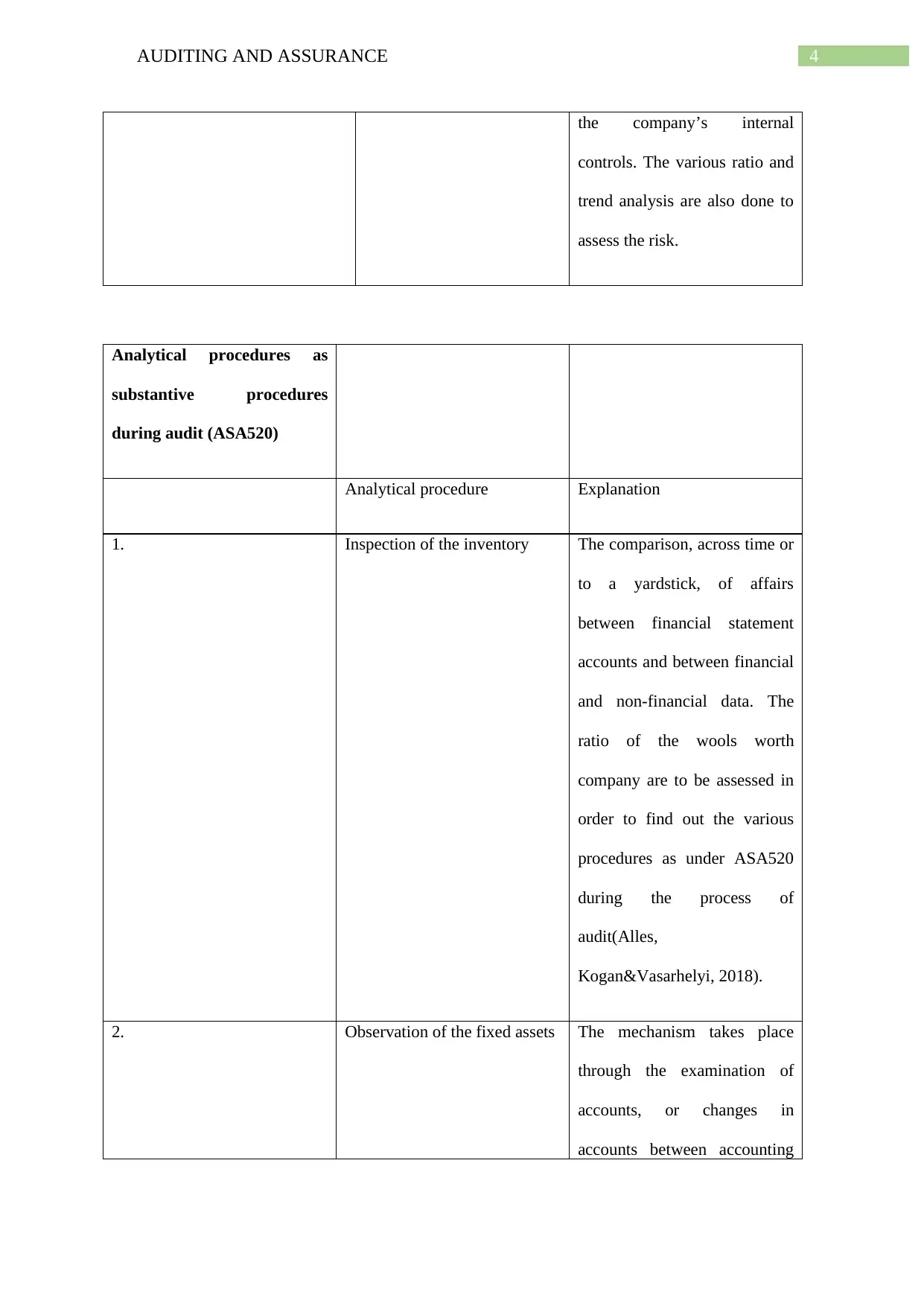
4AUDITING AND ASSURANCE
the company’s internal
controls. The various ratio and
trend analysis are also done to
assess the risk.
Analytical procedures as
substantive procedures
during audit (ASA520)
Analytical procedure Explanation
1. Inspection of the inventory The comparison, across time or
to a yardstick, of affairs
between financial statement
accounts and between financial
and non-financial data. The
ratio of the wools worth
company are to be assessed in
order to find out the various
procedures as under ASA520
during the process of
audit(Alles,
Kogan&Vasarhelyi, 2018).
2. Observation of the fixed assets The mechanism takes place
through the examination of
accounts, or changes in
accounts between accounting
the company’s internal
controls. The various ratio and
trend analysis are also done to
assess the risk.
Analytical procedures as
substantive procedures
during audit (ASA520)
Analytical procedure Explanation
1. Inspection of the inventory The comparison, across time or
to a yardstick, of affairs
between financial statement
accounts and between financial
and non-financial data. The
ratio of the wools worth
company are to be assessed in
order to find out the various
procedures as under ASA520
during the process of
audit(Alles,
Kogan&Vasarhelyi, 2018).
2. Observation of the fixed assets The mechanism takes place
through the examination of
accounts, or changes in
accounts between accounting
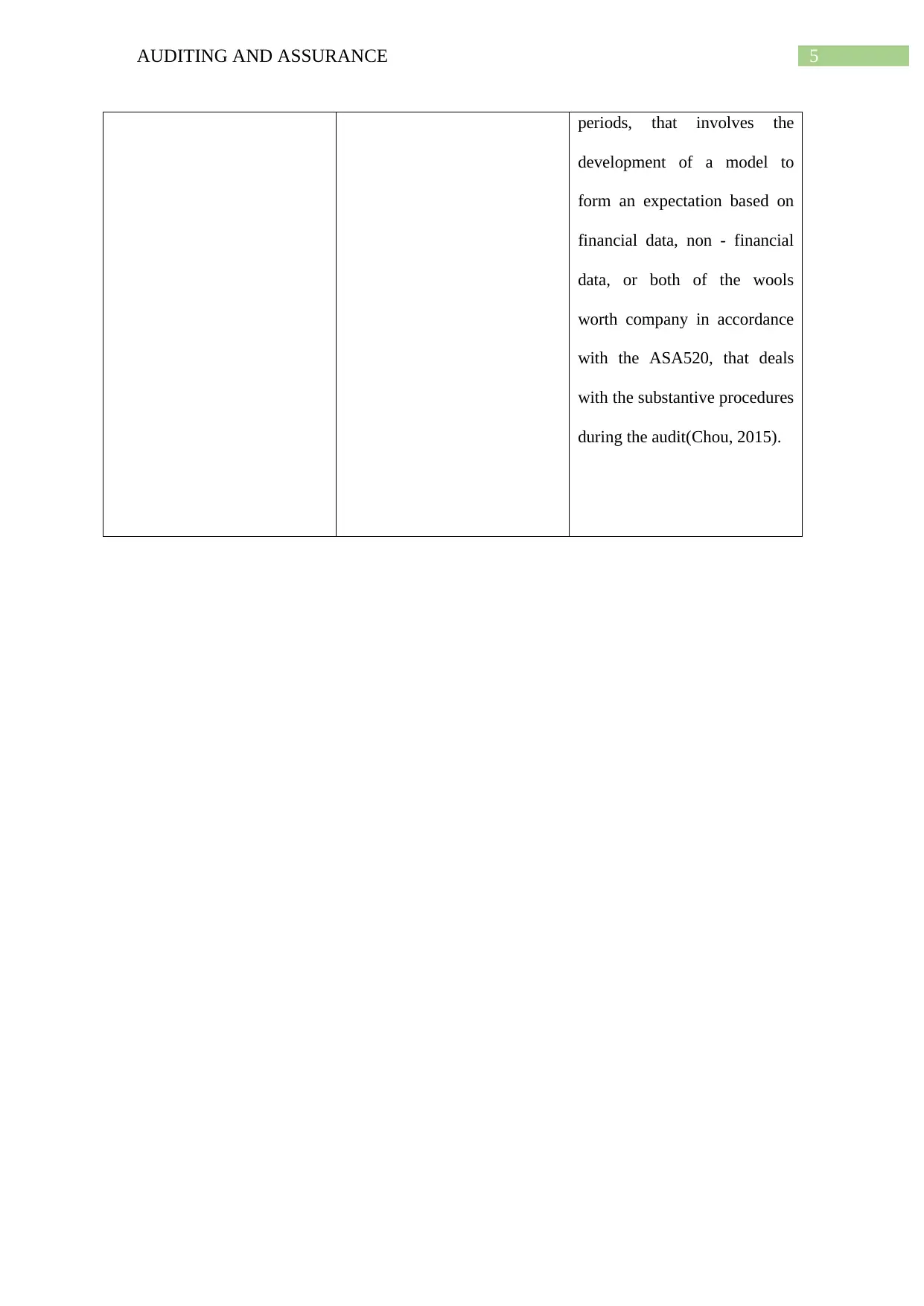
5AUDITING AND ASSURANCE
periods, that involves the
development of a model to
form an expectation based on
financial data, non - financial
data, or both of the wools
worth company in accordance
with the ASA520, that deals
with the substantive procedures
during the audit(Chou, 2015).
periods, that involves the
development of a model to
form an expectation based on
financial data, non - financial
data, or both of the wools
worth company in accordance
with the ASA520, that deals
with the substantive procedures
during the audit(Chou, 2015).
⊘ This is a preview!⊘
Do you want full access?
Subscribe today to unlock all pages.

Trusted by 1+ million students worldwide
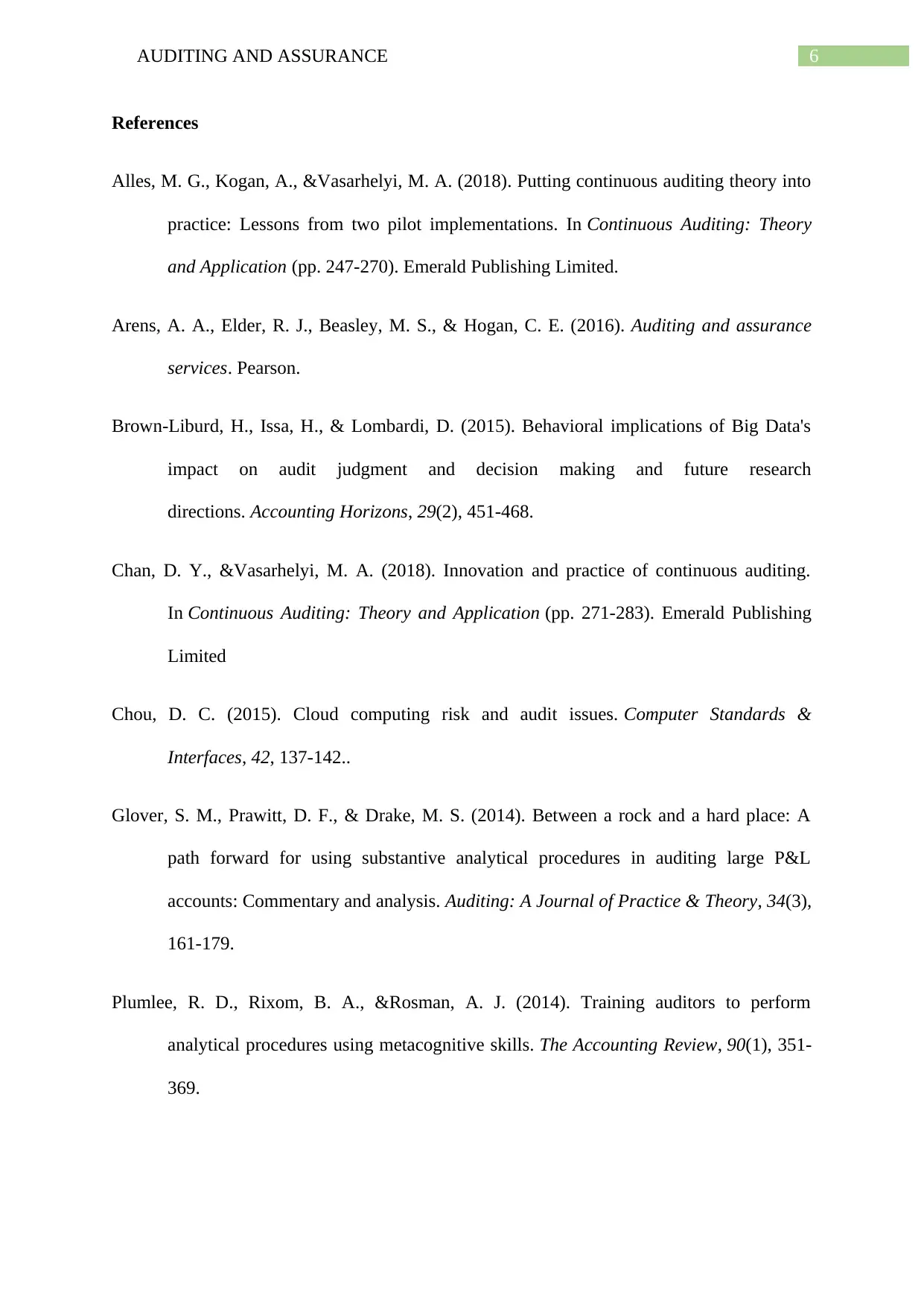
6AUDITING AND ASSURANCE
References
Alles, M. G., Kogan, A., &Vasarhelyi, M. A. (2018). Putting continuous auditing theory into
practice: Lessons from two pilot implementations. In Continuous Auditing: Theory
and Application (pp. 247-270). Emerald Publishing Limited.
Arens, A. A., Elder, R. J., Beasley, M. S., & Hogan, C. E. (2016). Auditing and assurance
services. Pearson.
Brown-Liburd, H., Issa, H., & Lombardi, D. (2015). Behavioral implications of Big Data's
impact on audit judgment and decision making and future research
directions. Accounting Horizons, 29(2), 451-468.
Chan, D. Y., &Vasarhelyi, M. A. (2018). Innovation and practice of continuous auditing.
In Continuous Auditing: Theory and Application (pp. 271-283). Emerald Publishing
Limited
Chou, D. C. (2015). Cloud computing risk and audit issues. Computer Standards &
Interfaces, 42, 137-142..
Glover, S. M., Prawitt, D. F., & Drake, M. S. (2014). Between a rock and a hard place: A
path forward for using substantive analytical procedures in auditing large P&L
accounts: Commentary and analysis. Auditing: A Journal of Practice & Theory, 34(3),
161-179.
Plumlee, R. D., Rixom, B. A., &Rosman, A. J. (2014). Training auditors to perform
analytical procedures using metacognitive skills. The Accounting Review, 90(1), 351-
369.
References
Alles, M. G., Kogan, A., &Vasarhelyi, M. A. (2018). Putting continuous auditing theory into
practice: Lessons from two pilot implementations. In Continuous Auditing: Theory
and Application (pp. 247-270). Emerald Publishing Limited.
Arens, A. A., Elder, R. J., Beasley, M. S., & Hogan, C. E. (2016). Auditing and assurance
services. Pearson.
Brown-Liburd, H., Issa, H., & Lombardi, D. (2015). Behavioral implications of Big Data's
impact on audit judgment and decision making and future research
directions. Accounting Horizons, 29(2), 451-468.
Chan, D. Y., &Vasarhelyi, M. A. (2018). Innovation and practice of continuous auditing.
In Continuous Auditing: Theory and Application (pp. 271-283). Emerald Publishing
Limited
Chou, D. C. (2015). Cloud computing risk and audit issues. Computer Standards &
Interfaces, 42, 137-142..
Glover, S. M., Prawitt, D. F., & Drake, M. S. (2014). Between a rock and a hard place: A
path forward for using substantive analytical procedures in auditing large P&L
accounts: Commentary and analysis. Auditing: A Journal of Practice & Theory, 34(3),
161-179.
Plumlee, R. D., Rixom, B. A., &Rosman, A. J. (2014). Training auditors to perform
analytical procedures using metacognitive skills. The Accounting Review, 90(1), 351-
369.
1 out of 7
Related Documents
Your All-in-One AI-Powered Toolkit for Academic Success.
+13062052269
info@desklib.com
Available 24*7 on WhatsApp / Email
![[object Object]](/_next/static/media/star-bottom.7253800d.svg)
Unlock your academic potential
Copyright © 2020–2025 A2Z Services. All Rights Reserved. Developed and managed by ZUCOL.




